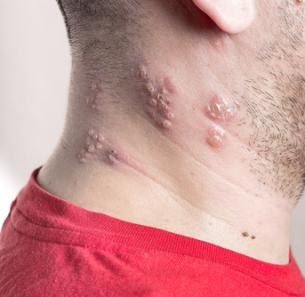
For those impacted by the painful virus known as shingles, one of the first questions asked is typical, “How long are shingles contagious?” The shingles virus is caused by the same virus as chickenpox, varicella-zoster, and causes inflammation of nerves beneath the skin. It can be extremely painful for the person infected, and the shingles contagious stage varies on a case-by-case basis. Sometimes spanning several weeks, timing around shingles depends on how early a diagnosis is made, how quickly a treatment plan is implemented and the overall quality of care administered.
About Shingles Signs and Symptoms
The external signs of shingles are considered evidence and confirmation of the disease. Signs of shingles typically include a bright red rash that envelops one side of the torso, neck, or face, and this rash is amplified by painful and contagious blisters that are filled with fluid and crust over upon breaking. Additional symptoms of shingles can include itching, headache, photosensitivity, fatigue, high fever as the body fights the virus, and sensitivity to touch.
While almost all people with shingles experience the intense symptoms of the virus, like pain, they may never develop the external rash. These people are generally not considered contagious but do experience pain to the touch. We recommend seeking immediate medical attention if you experience any of the symptoms associated with shingles for a proper diagnosis, particularly if any of these occur around the eye area. Shingles near the eyes can lead to serious ocular complications and even a loss of vision.
How Shingles Becomes Contagious
Shingles are contagious when direct contact is made with open shingles sores, and the varicella-zoster virus can spread to anyone not immune to chickenpox when blisters break and ooze fluid. It’s important to note that, upon direct contact with the varicella-zoster virus for the first time, the recipient will develop chickenpox, not shingles. An infected person is not contagious before blisters appear, and once blisters develop crusts, the virus is no longer considered contagious.
While shingles are typically not life-threatening, it’s important to acknowledge shingles can have a devastating impact on certain groups of people, as the disease can cause undue stress on the impaired, strained, or not-fully-developed immune system. If you or someone you know has shingles, it is especially important to avoid contact with the following:
- Infants and newborns
- People who have weak immune systems
- Women who are pregnant
How Long is Shingles Contagious and How Does Shingles Spread?

The shingles contagious stage is a window when the virus and resulting rash are at its peak, and varicella-zoster can be transmitted through sores that are open and not yet crusted over. Prior to blisters developing, and once crusty scabs form over blisters, the varicella-zoster is not considered transmittable. The typical length of a shingles outbreak is between two and six weeks
Shingles cannot be passed through common secretions like saliva or nasal secretions. Therefore, coughing or sneezing will not spread shingles. Additionally, it’s important to reiterate that shingles can only spread to someone who has never had chickenpox. Those who have already been infected by the varicella-zoster virus in the form of chickenpox already have the shingles virus lying dormant and cannot get the virus again, so even if a family member or friend is impacted, if you’ve already had chickenpox, you will not get chickenpox again.
Who is at Risk?
It’s unclear why the varicella-zoster virus can lay dormant and reactivate as shingles. While many believe decreased immunity with age is a factor, anyone who has endured chickenpox is susceptible. Certain demographics and factors, however, have an increased likelihood, including:
- People ages 50 and older are at an increased risk of developing shingles due to generally weakened immune systems.
- People enduring oncology treatments like radiation and chemotherapy may have lower immunity and resistance. This can allow the shingles virus to activate.
- People with diseases that impact the immune system, like HIV/AIDS, are at increased risk, as these maladies can decrease the body’s ability to ward off diseases like shingles.
If you are diagnosed with shingles, it’s important to discuss your options with your doctor, and determine which treatments may be best for you. With prompt diagnosis and treatment, the symptoms of shingles can be greatly reduced.
Some natural remedies can be beneficial alone or alongside prescribed medication. In terms of high-quality natural treatment for shingles, we like Naturasil, a homeopathic formula made without harsh chemicals. Naturasil works to diminish or eliminate the symptoms related to shingles, and to aid the body’s natural defenses in preventing future outbreaks. You can follow this link to go to the Naturasil website and learn more. Be sure to discuss all treatments with your doctor before using them.
